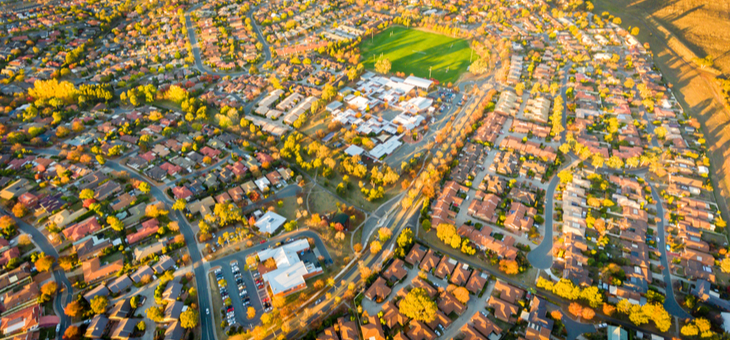Australia’s suburbs have been designed to make us ill, says Mike Day, co-founder and partner at Hatch RobertsDay – an award-winning urban planning and design consultancy.
Suburbs, communities or estates planned and built in the past 20 years are the biggest culprits, says Mr Day.
They’re built without sufficient public transport options, making residents car dependent – despite around 40 per cent of the population not having access to a car.
“Many people feel marooned in these suburbs where their daily needs are not within walking distance – and it’s having a dramatic impact on people’s mental and physical health,” says Mr Day.
The impact of COVID-19 in these areas has also exacerbated loneliness and social isolation.
According to an Australian Institute of Health and Welfare (AIHW) report, those without work or left at home while a partner is away suffer isolation contributing to physical and mental illness, poor sleep, high blood pressure, suicide and even premature death.
And yet the federal government continues to prioritise road building, which Mr Day believes contributes to an unhealthy environment and an unhealthy population.
Communities dominated by separated land uses and streets with limited access for pedestrians also affect residents’ wellbeing.
“Most suburban town planning not only separates land uses and people from each other, it has tended to discourage physical activity with a lack of cycle paths or connected walkways, leading to rising rates of obesity,” says Mr Day.
The number of Australians aged 18 and over who are overweight or obese has risen to 70 per cent in recent years – higher than for those living in the cities.
Read more: Obesity linked to social ties
Mr Day would like to see urban design and place strategies that encourage sustainable forms of transport such as walking along dedicated footpaths, use of e-bikes, push bikes and public transport options.
He says this would not only contribute to increased socialisation, but also reduce congestion and pollution, and would less expensive than building roads.
“The 20-Minute Neighbourhood concept is where we should be heading,” he says.
“It’s an urban design and health and wellbeing strategy that gives people the option to meet their daily needs within a 20-minute return walk from home, with access to safe cycling and local transport choices.
“The policy promotes sustainable transport, mixed-use, the UN Sustainability Goals and local workplaces. The Victoria government has committed to the strategy for Melbourne, but we need more councils to get on board.”
Mr Day says both young and older Australians are particularly disadvantaged by poorly planned neighbourhoods that cut them off from friends, family and essential amenities.
A lack of employment initiatives in suburban areas also forces people to commute long distances to work, compounding their stress and exhaustion.
“We need to emulate what our forebears have laid out and design places that are akin to those cherished, timeless inner-city neighbourhoods. Places that are compact and intimate, with a diversity of spaces that encourage and promote an inclusive community – we need to urbanise the ‘burbs,” says Mr Day.
Read more: Retire the retirement village
He believes it should be mandatory for children to be able to walk to school, citing Scotland and Canada as examples of countries fostering walk-to-school initiatives.
“When they are walking, children benefit from chance encounters, being immersed in urban and natural settings, instead of cocooned in a car,” he says.
The growth of Australia’s ageing population will also challenge urban planners and designers in the years ahead.
YourLifeChoices research shows that 54 per cent of older Australians would prefer to age in place with assistance from home care and 22 per cent aim to be fully independent until they die.
Prime Minister Scott Morrison has also suggested that the future of aged care should be in the home, making it imperative that urban planners create homes and neighbourhoods that support older Australians physically, mentally and socially.
Read more: Seven trends that will better integrate ageing Australians into their communities
Mr Day laid out suggestions for prioritising the health and wellbeing of residents in any suburb. They include the need for walkable environments that reduce the need for cars; separating cycle pathways from connected walkways; encouraging micro-mobility such as e-bikes and scooters, and increasing and improving public transport options including buses and trams.
Each community should have town or village squares located within walking distance of most residences, to provide a sense of place and belonging.
Towns need to go greener, too, building parks and other green spaces such as community gardens and rooftop gardens, tree-lined streets with wider footpaths and parking for cars at the rear of houses.
A mix of housing options such as terraces and townhouses would encourage a multi-generational population, while increased vertical density and mixed-use amenities such as schools, community centres, leisure centres and shops would also benefit residents.
Then, councils should curate cultural programs and events to enrich the community and promote diversity.
“Only through discovering the qualities and culture of places, and understanding the aspirations of the people who live in them, can we begin to collaborate on a vision for the future that can be realised in a way that works for everyone,” says Mr Day.
What do you think of Mr Day’s suggestions? Are you happy living in your community? Which facets of your suburb do you appreciate and which do you think could be better? Which are missing altogether? Why not share your thoughts in the comments section below?
If you enjoy our content, don’t keep it to yourself. Share our free eNews with your friends and encourage them to sign up.

